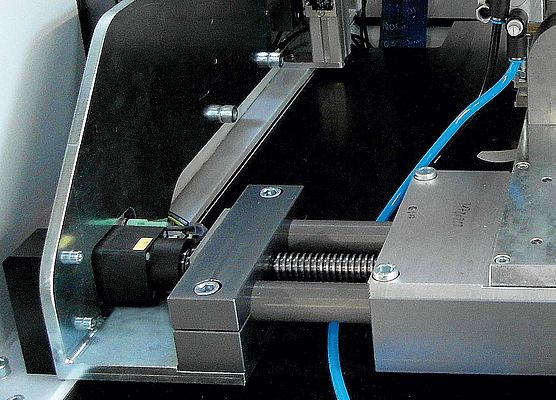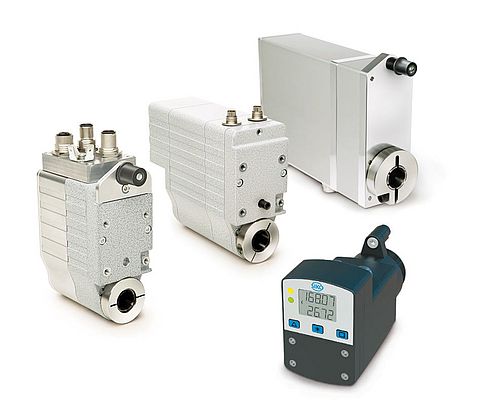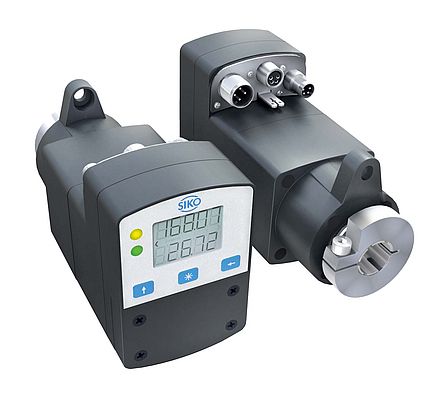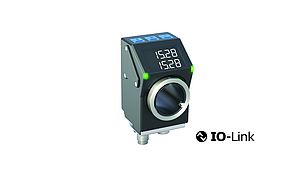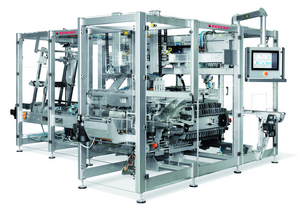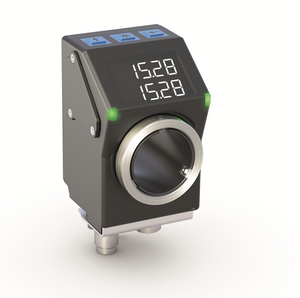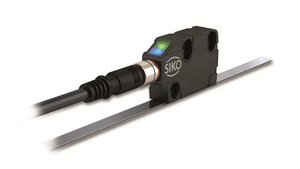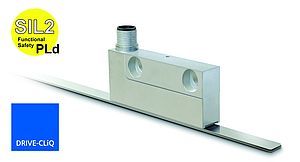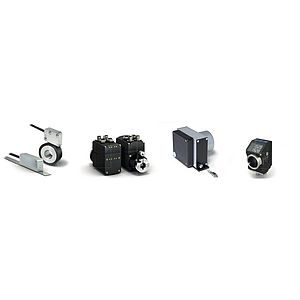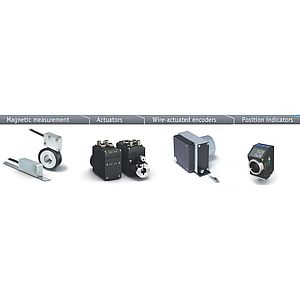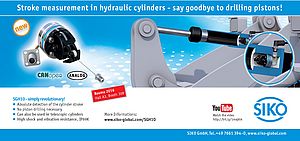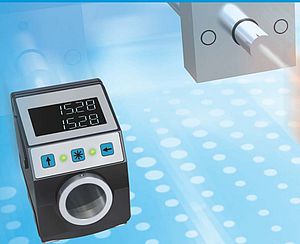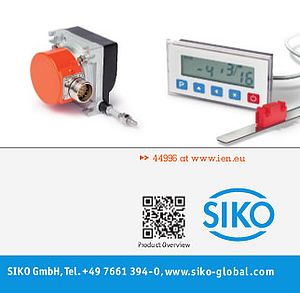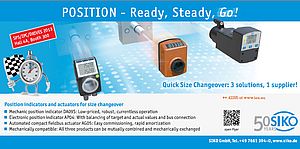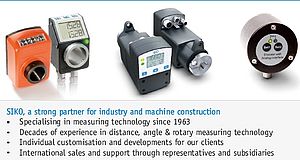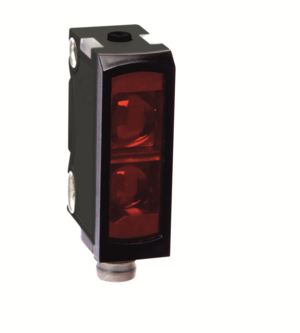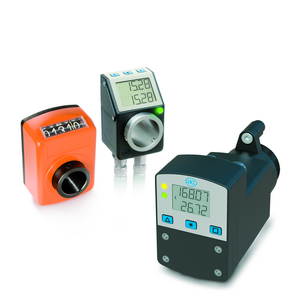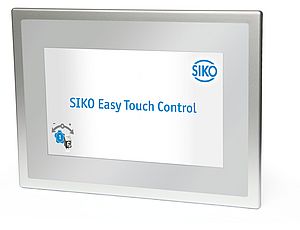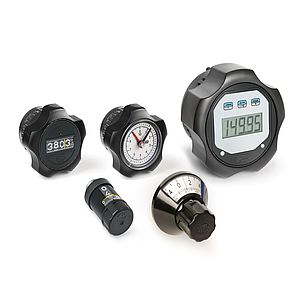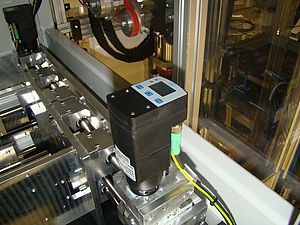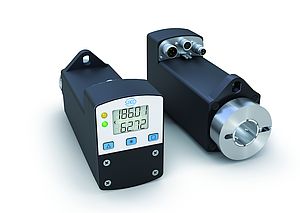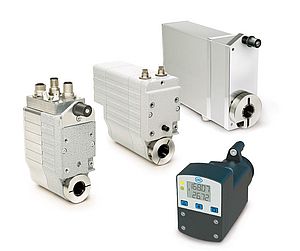Replacing manual regulating devices on spindles and adjustment axes with networked actuators means significant cost reductions thanks to time optimisation and an increase in product quality. But for most of these machines with cramped conditions, the available actuators were to date made to be that large that a replacement was not possible. Now with the new AG05 from the Siko DriveLine family there is an actuator on the market that not only impresses designers and users with its chic black plastic casing but also with its functionality and compactness.
A typical processing machine has numerous axes, stop collars and adjustment options so that it can be adjusted to the varying sizes of the individual products. Michael Schwab, DriveLine Product Manager at Siko GmbH in Buchenbach, says: "If the machine has 14 adjustment options, some of which are difficult to get to, then two men need around 10 minutes for a complete format change on a manual set-up. If all axes were automated with an actuator and the product is changed once an hour, this minimises set up times and increases performance by almost 15%." Or put another way: "The more axes a machine has to adjust, and the more often this has to occur, the quicker the additional costs for automation are amortised." With the AG05, Siko is unveiling another member of the actuator family that offers completely new automation possibilities thanks to its compact dimensions.
The first member of the product line, the AG01 actuator, was launched in 2002 and followed by the AG02 in 2003. In 2004, the AG02 was fitted with an integrated profibus DP/CANopen interface. The AG01 and AG02 were fitted with 70 and 150 Watt (respectively), 24 volt DC high performance motors. The actuators were boosted by their excellent value for money, simple control mode, long life cycle and high starting torque, which was capable of freeing spindles that were covered in dirt and grime. Depending on the transmission, an output torque of 1.1 to 9 Nm at 100 to 500 rpm, which was enough to take over the work from manual adjustment links. The innovative DriveLine compact actuator enabled the standby times of machines and systems to significantly be reduced. On the one hand this reduces the unproductive downtimes, and on the other it makes an environmental contribution with its energy-saving potential (compressed air and heating/cooling capacity).
If the AG01 requires a separate end stage, the AG02 has an integrated motor controller. Despite the differences there are also similarities. The full-length hollow shaft with a maximum shaft diameter of 14 mm is suitable for all actuators, from the AG01 to the AG03. The transmission's hollow shaft design facilitates assembly and start up, and the 1:1 replacement of manual adjustment elements means: remove the hand wheel or position gauge from the spindle, mount the actuator, lock it in place, done. The AG04B has a torque of 14Nm and a maximum 375 rpm, making it the most powerful actuator in the range. The AG04B has a maximum hollow shaft diameter of 20 mm and an optional spring brake.
The manufacturer offers its customers a wide range of spindles and axes for format adjustment from its own portfolio. The company offers mechanical hand wheels or traditional mechanical-digital position gauges through to semi-automated electronic position gauges with nominal/actual value comparison and bus connections, compact actuators such as the new AG05 for complete automation. The focus is on flexibility for the mechanical engineer and the end user. "It is up to the end user how he wishes to position his machine axes and spindles. This means he can pick the best adjustment method for each individual axle and thanks to the hollow shaft design, he can replace the hand wheel with a compact actuator, such as the AG05," explains Michael Schwab.
Small as a 0.33-litre drinks bottle
The AG05 is an enhancement of the previous actuator and exceeds it many times over when it comes to functionality. The start up takes place either directly on the actuator itself or via bus communication. No additional material is required for the assembly. The programming effort and the set-up and adjustment times are minimal, enabling rapid activation. The user is perfectly supported through the simple start-up procedure by a two-row display. It also enables the nominal and actual values to be observed during operation.
A brushless 24-volt DC motor with a planetary gear, controller, power electronics and integrated field bus interface is inside the black plastic case. The innovative actuator boasts excellent smooth operation with an impressive power density of 30 W/dm³.
The inclusion in different safety concepts is very easy to implement as the voltage supply is separate for the controlling and power electronics. The superordinated SPS is greatly assisted by the integrated controlling electronics. Monitoring functions for temperature, power and contouring errors are already integrated into the actuator. The battery's charge level is monitored continuously so that a replacement, which the user can do himself, is displayed or reported in good time. By buffering the battery of the magnetic low-power consumption (LPC) measurement system, position deviations are also recorded in powerless states and a renewed referencing becomes unnecessary.
Precisely positioned, precisely reproduced
Actuators with bus connections minimise a machine's set-up times, as previously stated. There are further positive effects thanks to the ability for position monitoring. During production it is often necessary to work with extreme positional precision and to continually take the position setting from the reference side. Manually adjusting the axles means it is very difficult to adhere to these rules, let alone assure them, which impacts on production quality and results in more waste. By contrast, an actuator ensures precise positioning with a high level of reproducibility. The measurement system monitors the 360° of a turn with 1,600 steps, which corresponds to a resolution of 0.225°. Depending on the gradient and quality of the spindle it produces a positional precision that can be barely attained manually. The wear and tear-free magnet technology in the LPC measurement system is also impervious to dirt, moisture, shocks and vibrations. A magnetised ferrite ring sits without play on the pinion shaft and transfers its gyrations to the evaluation electronics via a sensor. This changes the number of the north-south pole detected at the gyration into an impulse and from it determines the rotation angle and thereby the travelled distance.
Automation saves time and money
Constant product changes and highly variable product sizes are the norm in many branches and require numerous adjustment and alignment effort on the advance and auxiliary axles. Examples of this are production machines from the areas of metal, packaging, wood, glass, pressing and plastic industries as well as tooling machines. The minimising of non-productive machine times and the amount of waste produces has a great influence on the efficiency and profitability of a company. The mechanical development of machines is now so far along that only increased automation can save time and money. This explains the increasing demand for actuators. The adjustment is roughly four-times quicker and much more precise than when done manually. With the new AG05, it will also be possible to fit actuators to machines that previously could not have one due to cramped conditions.


